Distance and length of time: Vic-Sant Pere de Casserres (24,6km-29min) | Sant Pere de Casserres-Montesquiu (40,7km – 48min) | Montesquiu-Ripoll (16,8km-26min) |Ripoll-Sant Joan de les Abadesses (14km-32min)

VIC CATHEDRAL
- Adress: Plaça de la Catedral, 1, 08500 Vic, Barcelona
- Contact: 938 862 091 | turisme@vic.cat | www.victurisme.cat
- GPS Coordinates:N 41º 55’ 40.707” E 2º 15’ 17.726”
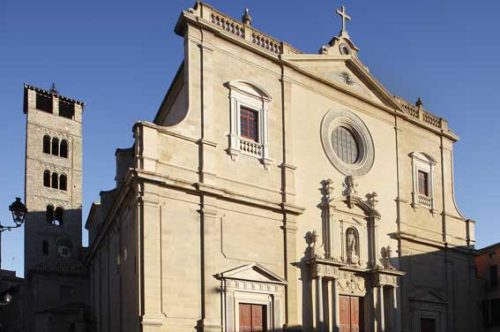
The cathedral was consecrated by the then Bishop Oliba in 1038 but only the bell-tower and crypt, both features of the high Catalan Romanesque period, remain standing and date back to the original building. There are more archaeological remains below the surface of what was, Santa Maria la Rodona.
The main nave is greatly enriched thanks to the largest collection of paintings by the Catalan turn-of-the century Artist Josep Maria Sert.
Car parking: Free parking nearby, payment parking nearer at hand.
Nearby services: The cathedral is near the centre of Vic, which means there are many bars, restaurants, places to stay and shops to choose from.
Entrance fee:
Free for the main nave.
The Romanesque Crypt, main altarpiece and gothic cloisters: 3€ per person.
Under 18 year-olds, retired people and groups of and over 10 people: 1€ per person.
Opening times:
Every day from 10AM to 1PM and from 4PM to 7PM.
Once in Vic you must visit the Market Square, the Roman Temple, the Castle of the Montcada family, as well as the Vic Episcopal Museum, which is one of the greatest references of Romanesque art in Europe, and has a section dedicated to the Bishop and Abbot Oliba. For more information visit: www.victurisme.cat
VIC EPISCOPAL MUSEUM – THE OLIBA ROOMS
- Adress: Plaça del Bisbe Oliba, 3, 08500 Vic, Barcelona
- Contact: 938 869 360 | informacio@museuepiscopalvic.com | www.museuepiscopalvic.com
- GPS Coordinates:N 41º 55’ 43.414” E 2º 15’ 20.572”
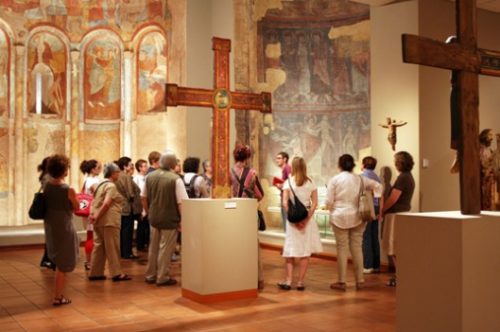
The Episcopal Museum was opened in 1891 and conserves a magnificent collection of medieval art by master artists and sculptors belonging to the Catalan Romanesque and Gothic eras. The collection of gold and silverwork, textile, ironwork, glass and ceramics, takes you on a virtual journey through liturgical history and decorative art in Catalonia. This exceptional collection has more than 29,000 objects, and can be viewed in the purpose-built museum next to the cathedral that integrates a top-notch innovative exposition.
Car parking: There is free parking at some distance and underground payment car parks nearby.
Nearby services: The museum is in the centre of town and has a range of bars, restaurants, places to stay and shops near at hand.
Entrance fee:
Entrada individual – 8 €
Yearly fee– 12 € (Free entrance during a year from the date of purchase).
Reduced fee for groups- 5 € (From 15 people up)
Reduced fee – 5 € (Retired and unemployed people, children and teenagers between 10 and 18 years old, the disabled including the carer, holders of student cards, ‘carnet jove’ holders, holders of ‘familia nombrosa’ (more than three children) or ‘single parent’ card holders, and holders of the TV3 club card TR3SC.
Free entrance (Under 10 year-olds, membres of ICOM and the Association of Museologists, the first Thursday of every month (except holidays and local festivities), the 18th of May (International day of Museums), the 5th of July (Vic’s town festival), students (with accredited investigation studies, the MEV staff, Civil servant teachers and professors who work for the Catalan government, The Generalitat of Catalonia, Friends of the National Museum of Art of Catalunya and accredited journalists.
TEMPORARY EXHIBITIONS
General fee – 3 €
Ticket for main museum + temporary exhibition. – 8 €
Ticket for reduced free for main museum + temporary exhibition.– 5 €
Opening times:
From Tuesday to Friday from 10AM to 7PM (April to September).
From Tuesday to Friday from 10AM to 1PM and from 3PM to 6PM (October to March).
Saturday from 10AM to 7PM
Sunday and local or national holidays (10AM to 2PM)
The museum closes on Mondays; the 1st and 6th of January; Easter Monday and the 25th and 26th of December. Tickets are on sale up to half an hour before closing time.
Remember not to miss the market square on Tuesday and Saturday mornings, the Roman Temple, the Castle of the Montcada family as well as the Vic Episcopal Museum, one of Europe’s greatest references of Romanesque Art, that has rooms dedicated to the Bishop and Abbot Oliba. For more information please visit www.victurisme.cat
MONASTERY OF SANT PERE DE CASSERRES
- Adress: Carretera, BV-5213, 08510 Masies de Roda, Barcelona
- Contact: 937 447 118 | 608 892 200 | monestirdecasserres@ccosona.cat | www.santperedecasserres.cat
- GPS Coordinates: N 42º 0’ 5.487” E 2º 20’ 18.59”
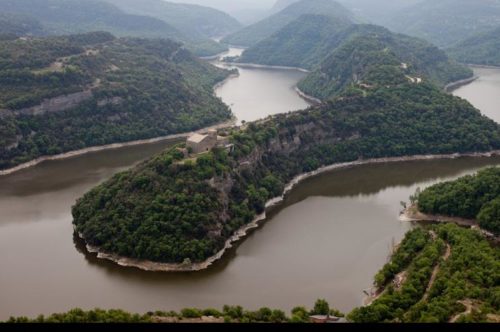
This is one of the most important Catalan Romanesque monumental buildings and the only Benedictine monastery in the county of Osona. It is also a listed building of Cultural interest. It is located at the far tip of a high hill ridge and surrounded by the meandering River Ter just before it flows into the Sau reservoir.
Car Parking: Free parking.
Nearby services: The monastery has a bar and restaurant. There is a Parador de Turisme hotel nearby.
Entrance fee:
Standard: 3€
Reduced: 1.5€
Free for under 7-year-olds.
Opening times:
From the 1st of June to the 30th of September from 10AM to 7.30PM
From the 1st of October to the 31st of May from 10AM to 5PM
Tickets are sold up to 30 minutes before closure.
Further information:
One can also walk from the Parador de Turisme along a 3.5km path through the forest with lovely views of the reservoir.
BELLMUNT SANCTUARY
- Adress: Camí de Bellmunt, S/N, 08572 Sant Pere de Torelló, Barcelona
- Contact: 937 447 107 | 638 343 992 | http://santuaridebellmunt.blogspot.com.es/
- GPS Coordinates: N 42º 6’ 6.569” E 2º 17’ 32.632”
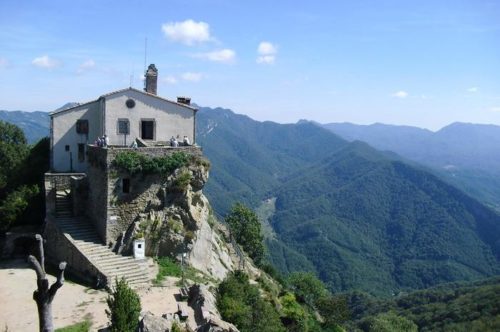
Bellmunt sanctuary is at 1,246 metres above sea level. ‘A hermitage suspended in the air’ Jacint Verdaguer, the poet, called it. The first reference of the site is 1219. It has the most spectacular panoramic views both of the counties of Osona and the southern part of El Ripollès. On clear days one can see as far as Montserrat and the peak of the Pedraforca mountain.
Car parking: Free parking.
Nearby services: The sanctuary has a mountain refuge, as well as a bar and restaurant.
Entrance fee: Free.
Opening times:
November, December, January and February: weekdays from 10AM to 2PM. Saturdays, national and local holidays from 10AM to 2PM and 4PM to 6PM.
March, April and October: Weekdays, Saturdays and national and local holidays from 10AM to 2PM and 4PM to 6PM. May, June and September: Weekdays, Saturdays and holidays and local festivities from 10AM to 2PM and 4PM to 7PM.
July and August: Weekdays, Saturdays and national and local holidays from 10AM to 7PM.
THE CASTLE OF MONTESQUIU
- Adress: Castell de Montesquiu – 08585 Montesquiu, Barcelona
- Contact: 938 529 234 (information and bookings) i 934 727 600 (office) | p.montesquiu.biscaura@diba.cat | https://parcs.diba.cat/web/montesquiu
Times: from Tuesday to Sunday from 9am to 2.30pm - GPS Coordinates: N 42º 6’ 47.88” E 2º 12’ 44.027”
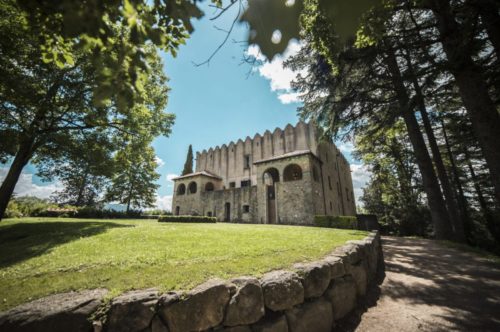
The castle of Montesquiu might possibly have originated as a guard tower built by Guifré 1 (el Pilós, the hairy one), in the 9th century. It isn’t until mid 14th century that what we know as a castle, changes its purely defensive nature to become a residential fortified home or hall. Arnau Guillem de Besora is the first in his line to live here.
The hall is extended and refurbished to become Lluís Descatllar’s noble residence in the 17th century. The chapel that now exists is also thanks to Descatllar, as is the extension to the North-East, as well as other additions that would have signified important changes to the overall look of the building at that time. At the start of the 20th century, a well-known high bred man called Emili Juncadella, embellished it and gave it its castle-like appearance, completing the surrounding area with gardens. These additions unfortunately hid many of the features and reconstructions that illustrated its architectural evolution. Luckily the castle is closer to its more meaningful architectural periods now, after a well researched intervention, and it has recovered its ties with the surrounding land and villages and been carefully integrated again into what is now known as the ‘Parc’ of Montesquiu.
Car parking: Free parking.
Nearby services: In the centre of Montesquiu, half a kilometre away, there is a restaurant and bakery as well as other little shops and services.
Entrance fee including a guided tour:
Free entrance for children under 12.
Price for youngsters from 12 to 18 years olds: 2.00 euros
Price for adults from 18 to 64 year olds: 3.50 euros
Price for over 65 year olds:: 2.50 euros
Price for groups between 20 and 40 people: : 1.50 euros per person.
Discounted price for holders of the ‘Carnet Jove’, or student card holders (below 25-year-olds): 2.00 euros
Opening times during the year:
The castle is open from November to March: weekends and local and national holidays from 10AM to 2.30 PM. from April to June and September to October: Saturdays and local and national holidays from 10AM to 2.30PM and from 4PM to 6PM and July and August it is open from 10AM to 2.30PM from Tuesday to Sunday.
Visiting times:
The visits begin at 10.30AM, 11.30 AM, 12.30 AM i 1.30 PM and at 4.15PM and 5.00PM only when open in the afternoons.
For groups from 20 people or more, groups arranged in advance
For groups of more than 20 people please book a visit, which can be at any agreed time..
RIPOLL MONASTERY
- Adress: Plaça Abat Oliba,s/n – 17500 Ripoll, Girona
- Contact:972 704 203 | informacio@monestirderipoll.cat | www.monestirderipoll.cat
- GPS Coordinates: N42º 12’ 5.154” E 2º 11’ 26.497”
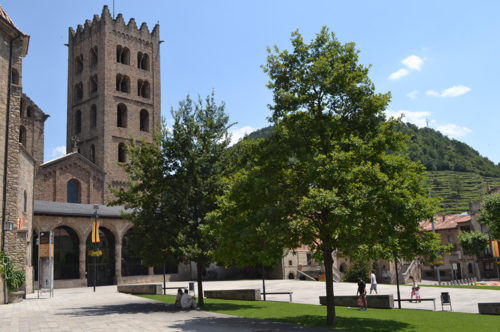
The monastery was founded by Guifré el Pelós the year 879. It was key to the awakening of the Romanesque style in the Catalan Counties. Oliba became a monk in 1002, at the age of 31 and in 1008 he was chosen to be the monastery’s abbot. Thanks to its 12th century outstanding carved stone doorway, it is candidate to be declared a UNESCO World heritage site.
Car parking: There are payment fee car parks nearby.
Nearby services: The monastery is in the centre of Ripoll, where there is a range of restaurants, shops and places to stay.
Prices:
Standard entrance fee: 6.80€
Discounted entrance fees:
Under 25 and over 65 anys: 5.00€
4 to 12 year-olds: 2.75€
Standard: 6.80€
Groups of up to 20, retired or unemployed people, young people between 13 and 25, people visiting with someone who has permanent residence in Ripoll, ‘large family’ card holders or ‘single parent’ card holders: 5.00€
Children between 5 and 12 years old: 2.75€
Schools: 2.5€
* Please enquire for these discounts:
Under 5 year-olds, Ripoll residents, all Ripollès schools, accredited members of ICOM, Official guides accredited by the Catalan Government.
Guided tours in Catalan or Castilian for up to 30 people: 70€/group (the entrance fee is not included)
Guided tours in English or French for up to 30 people: 80€/group (the entrance fee is not included).
Groups must book beforehand.
Opening times:
Spring-Summer timetable (From 1st April to 30th of September)
Mornings: from 10AM to 2PM
Afternoons: from 4PM to 7PM (Sundays of July and 2 first Sunday of September)
Sundays and local and national holiday: 10AM to 2PM.
From the 1st of July to the 22nd of August:
Sundays from 10AM to 2PM and 4PM to 7PM.
Autumn-Winter timetable (From 1st October to 30th March) Mornings from 10.00AM to 1.30PM.
Afternoons: Everyday from 3.30PM to 6PM
Mornings: Only Sundays and local and national holidays: from 10AM to 2 PM.
Christmas season opening times.
25th and 26th of December; 1st and 6th January: CLOSED
24th and i 31st of December and 5th January: 10AM to 2PM.
Guided visits every Sunday at 12PM.
Complimentary museums: Centre for the interpretation of the Monastery and The Ripoll Ethnographic Museum of Ripoll.
MONASTERY OF SANT JOAN DE LES ABADESSES
- Adress: Pl. de l’Abadia, s/n – 17860 Sant Joan de les Abadesses, Girona
- Contact:972 722 353 | info@monestirsantjoanabadesses.cat | www.monestirsantjoanabadesses.cat
- GPS Coordinates: N42º 13’ 57.591” E 2º 17’ 9.941”

Its church is one of the Jewels of Catalan Romanesque Art, the ‘Extremely Saintly Mystery’ or Santíssim Misteri,’ a historic must for pilgrimage. Founded in 885 by Guifré el Pelós and led by his own daughter, Emma, and the Abbot Oliba was greatly influential in obliging the convent to cease to be for women, due to the accusation that the nuns were leading a dishonest life.
Car Parking: Free.
Nearby services: The monastery is in the centre of the village, which means there are places to stay, restaurants and shops at hand.
Entrance fee:
Standard entrance fee: 3€
Reduced Entrance fee (groups, school children and retired people) : 2€
Free entry for children under 12s.
Opening times:
November, December, January and February: Weekdays from 10AM to 2PM. Saturdays and local and national holidays from 10AM to 2PM and 4PM to 6PM.
March, April and October: Weekdays, Saturdays and local and national holidays from 10AM to 2PM and 4PM to 6PM.
May, June and September: Weekdays, Saturdays and local and national holidays from 10AM to 2PM and 4PM to 7PM. Further information:
At Sant Joan de les Abadesses, you must also visit the Abbey Palace, and the Malatosca Gorge. For more information please visit: www.santjoandelesabadesses.cat
OTHER POINTS OF INTEREST ALONG THE ROUTE
The Sant Martí (St. Martin) Church of Riudeperes, in Calldetenes: The Romanesque church of Sant Martí was documented in 1050, and altered in the Romanesque period, when a doorway and atrium were added to the western wall and thus incorporated into the body of the building. Two lateral chapels were added In the 16th and 17th centuries. The ornamented capital is outstanding as is the fragment of the archivolt that dates back to the 12th century.
The Church of Sant Julià (St. Julian) de Vilatorta. This is of Romanesque origin, with baroque altarpieces. It is included in the Inventory of architectural heritage of Catalonia.
The Church of Santa Maria (St. Mary) de Folgueroles. The main nave was modified during the 12th and 13th century and the western side suffered changes with the construction of an atrium.
The Church of Sant Esteve (St. Stephen) de Tavèrnoles . This church was documented in the year 981 and considered within the boundaries of the Castle of Savassona. The present day building dates from 1070. It was given monastic suffrage linking it to the church at Sant Pere (St. Peter) de Casserres.
The Church at Santa Maria (St. Mary) de Vilanova de Sau: This romanesque church from the 11th century is located in the middle of the village.
Sant Romà (St. Roman) de Sau: This village is below the water now due to the reservoir that covered it, and only the top of the bell-tower is visible if the level is high, and, when it drops, part of the abandoned village appears again. Sant Romà dates back to the years 1025 and 1050 according to documents. The primitive church was replaced by a new one between the year 1061 and 1062. This church in turn was modified various times, with additions such as lateral chapels being incorporated into the walls, as well as the roof being raised. Later on, in 1769, the apse was removed.
The Sau reservoir: The reservoir was officially opened in 1963, and changed the look of the Sau Valley from that day. The village of Sant Romà disappeared forever under the water and only the belltower can still be seen from time to time. Despite this, Vilanova, the nearby village above the reservoir, thrived and developed into a tourist and leisure centre combining history and change. The reservoir became an attraction for the municipality that cover the territory from the valley up to the forested slopes called the Guilleries (the Fox lands), and the clear running streams that are perfect for river fishing.
